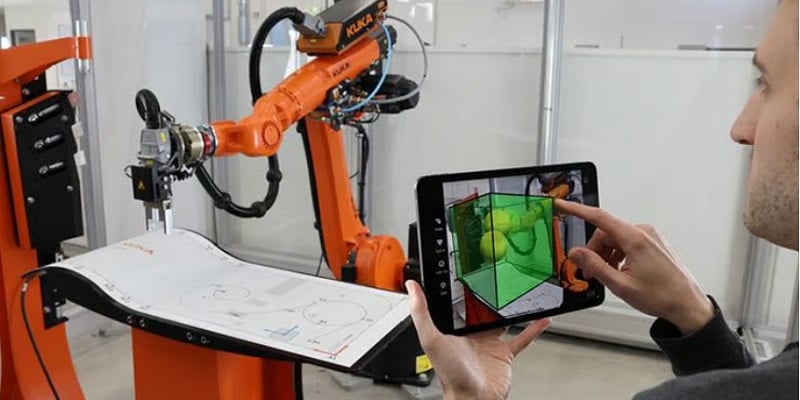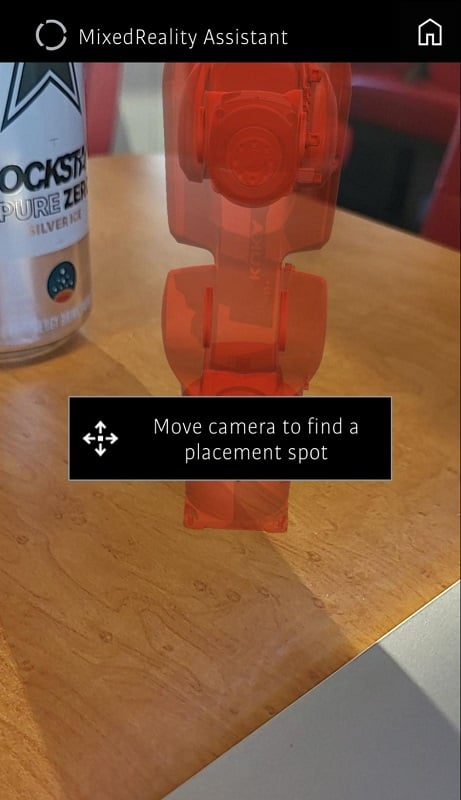KUKA Robotics Mixed Reality Software Improves Motion Programming
KUKA.MixedReality Assistant helps engineers visualize robotic motions before programming or deployment in order to accelerate robot start-up, one of the hardest parts of automation.
KUKA's robotics research team has recently released a new augmented reality (AR) software package that allows engineers to envision how robots move to help them avoid collisions and trace out effective motion paths. The KUKA.MixedReality Assistant and the KUKA.SafeOperation require little hardware to fully implement and can be tested without a robot at all.
Augmented Reality (AR) in Industry
Augmented reality (AR) has become a way to integrate the virtual world with the real world in a helpful manner. Typically, AR overlays real-world objects with text, graphics, and additional information so that when viewed through special hardware or a tablet or smartphone screen, the real-world object also displays additional information.
AR, as an industrial-quality tool, has been used to help train technicians on the safe operation of equipment, guide engineers through troubleshooting processes, and remotely connect service departments with field equipment. For example, wire bundles routed through a complex piece of equipment can be highlighted, and their purposes shown on the screen instead of requiring the technician to trace them or scour datasheets
KUKA.MixedReality Assistant
The KUKA.MixedReality Assistant can help technicians and engineers map out robot motion using AR. Instead of programming a robot and relying on sensors to detect potential collisions (or worse yet, having a collision), this software package can map out where the robot will move before the first motor begins to turn.

An engineer checks the gripper’s motion for potential collisions using KUKA.MixedReality Assistant. Image used courtesy of KUKA
Available as a free download onto a smartphone or tablet from the Google Play store or the Apple app store, KUKA.MixedReality Assistant can be used easily by virtually anyone. It comes equipped with a demonstration mode that does not require a real robot. When the user would like to interface with a real robot, they can simply connect both their electronic device and the robot through a WiFi hub.

The author is desperately trying to place a robot on the table that will hand him his energy drink. Image used courtesy of the author and KUKA.MixedReality Assistant software
One of the less obvious advantages of this type of software package is that machines can be packed more closely together. Consider an assembly line where multiple robots work on a device. The traditional method of performing this task is to ensure that robots are completely out of the reach of each other, spreading them out so that they will never collide. However, some of these robots have a long reach, meaning the manufacturing cell must have a large footprint. Instead, consider a small manufacturing cell where robots work in concert with each other, existing within each other’s work envelope, where one holds a part down while another tightens fasteners. A smaller footprint, faster assembly, and more efficient motion are possible.
Visualize The Future with AR
AR will continue to be a growing field. With the labor market in such dire straits, new, inexperienced workers will need to be rapidly trained in technical roles. With AR as a tool for training, testing, and troubleshooting, it will continue to be adopted by industry and manufacturing outfits as a tool to bring new workers up to speed. KUKA.MixedReality and KUKA.SafeOperation will be part of this growth process in industries where robots pick, pack, and assemble components, with motion in three dimensions.






